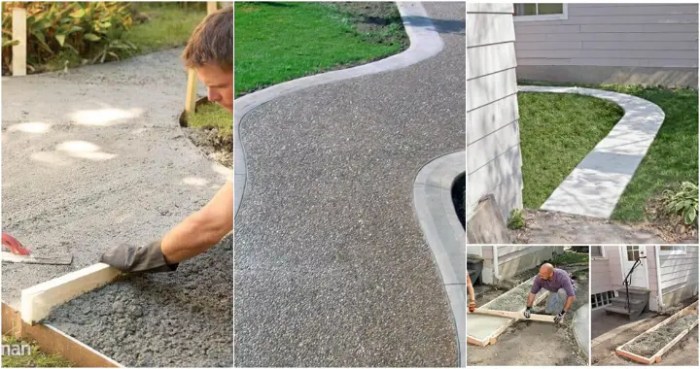DIY concrete walkway sets the stage for a rewarding and transformative project, allowing homeowners to enhance their outdoor spaces with a durable and stylish pathway. From planning and material selection to pouring, finishing, and maintenance, this comprehensive guide provides a roadmap for creating a beautiful and functional walkway that will stand the test of time.
This guide covers everything from the basics of planning and design to the intricacies of pouring and finishing concrete. We’ll also discuss the importance of proper curing and sealing, as well as ways to add decorative touches and personalize your walkway. Whether you’re a seasoned DIYer or a novice, this guide will provide you with the knowledge and confidence to tackle this project successfully.
Planning Your DIY Concrete Walkway

A well-planned concrete walkway is the foundation for a successful project. It ensures your walkway is functional, aesthetically pleasing, and lasts for years to come. Careful planning helps you avoid costly mistakes and ensures your vision is realized.
Essential Considerations for Planning Your Walkway
Before you start digging, consider these key aspects:
- Size and Shape: Determine the walkway’s width, length, and shape. A wider walkway provides more space for walking and allows for furniture placement. Consider the surrounding landscape and how the shape complements the overall design. For example, a curved walkway can add visual interest and soften a sharp corner.
- Location: Choose a location that meets your needs and complements the surrounding environment. Consider factors like sunlight exposure, drainage, and proximity to your home or other structures. Ensure the walkway is easily accessible and avoids obstacles.
- Desired Features: Consider adding features like decorative borders, stepping stones, or even built-in seating to enhance your walkway’s appeal. Think about the overall style you want to achieve and choose features that align with your vision.
- Materials: Choose materials that are durable and complement your home’s style. Concrete offers a wide range of colors, textures, and finishes to customize your walkway. You can also explore options like pavers or stamped concrete for added visual interest.
- Budget: Set a realistic budget for your project, including materials, tools, and labor costs. Research different options and consider the long-term costs of maintenance and repairs. A well-planned budget helps prevent overspending and ensures you can achieve your desired outcome.
Obtaining Necessary Permits and Approvals, Diy concrete walkway
In many areas, obtaining permits and approvals for construction projects is essential. Check with your local building department for specific requirements. These requirements can vary based on your location and the project’s scope. Failing to obtain necessary permits can result in fines or even the removal of your walkway. It’s always better to be safe than sorry and ensure you comply with all local regulations.
Curing and Sealing the Concrete

Curing is a crucial step in the concrete construction process, as it allows the concrete to gain strength and durability. Proper curing ensures that the concrete reaches its full potential and resists cracking, spalling, and other forms of deterioration.
Curing Methods
Curing involves maintaining moisture and temperature control within the concrete to promote hydration, the chemical reaction that transforms cement paste into a hardened, solid mass. There are several methods for curing concrete, each with its own advantages and disadvantages.
- Water Curing: This method involves continuously keeping the concrete surface wet, typically by spraying or flooding it with water. It’s a simple and effective method, but it requires constant monitoring and can be wasteful of water.
- Plastic Sheeting: Covering the concrete with plastic sheeting helps retain moisture and prevents evaporation. It’s a cost-effective method and relatively easy to implement.
- Curing Compound: Curing compounds are liquid or spray-on materials that create a moisture-retentive film on the concrete surface. They are typically formulated to evaporate slowly, providing long-term moisture retention.
Applying Sealants
Concrete sealants are protective coatings that help prevent stains, moisture penetration, and weathering damage. They create a barrier on the concrete surface, enhancing its durability and appearance.
- Penetrating Sealants: These sealants penetrate the concrete pores, creating a barrier that repels water and stains. They are typically used on porous surfaces like concrete pavers or driveways.
- Film-Forming Sealants: These sealants form a protective film on the concrete surface, providing a barrier against water, oil, and other contaminants. They are often used on decorative concrete surfaces to enhance their appearance and durability.
With careful planning, proper materials, and a bit of elbow grease, you can create a DIY concrete walkway that will enhance the curb appeal of your home and provide a lasting and functional pathway for years to come. Remember, the key to success is in the details, from the initial planning stages to the final finishing touches. So, embrace the challenge, and let your creativity guide you as you embark on this rewarding DIY project.
Creating a DIY concrete walkway can be a rewarding project, allowing you to personalize your outdoor space. Just like adding a touch of flair to your outfit with DIY earrings beads , you can incorporate unique elements into your walkway. From decorative stones to patterns, the possibilities are endless.
